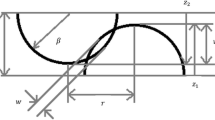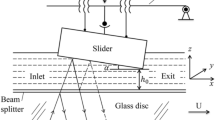Abstract
To evaluate the effects of surface roughness for a slider bearing operating under partial or boundary lubrication, a new approach with both stochastic and contact characteristics is proposed. It has become important to study the phenomenon of asperity contact in bearings because the growth of contact area under heavy load conditions induces severe changes in their performance. In this study, average flow factors derived according to Patir and Cheng were used and a model for multi-asperities contact was incorporated to calculate the tribological performance of a bearing with random surface roughness. An analysis using the modified Reynolds equation with both the average flow model and the contact model of asperities was conducted and compared with previous findings. The results showed that the influence of roughness parameters on friction and load capacity increased rapidly upon application of asperities contact.
Similar content being viewed by others
Abbreviations
- W :
-
total resultant load
- W p :
-
load supported by hydrodynamic pressure
- p:
-
hydrodynamic pressure
- W c :
-
load supported by normal stress of the asperity contact area
- σ c :
-
normal stress of the asperity contact area
- A n :
-
apparent area of bearing surface
- A r :
-
real contact area of bearing surface
- F r :
-
total friction force
- F p :
-
force of fluid friction due to shear stress
- τ p :
-
shear stress
- F c :
-
shearing force due to shear stress of the asperities in contact between the bearing surface
- τ c :
-
shear stress of the asperities in contact between the bearing surface
- h t :
-
local film thickness
- h :
-
nominal film thickness
- δ 1, δ 2 :
-
random roughness amplitudes of the two surfaces
- Ø x , Ø y :
-
pressure flow factor
- Ø s :
-
shear flow factor
- x :
-
length of the model bearing for simulation
- y :
-
width of the model bearing for simulation
- \(\overline p \) :
-
mean value of pressure
- \(\overline {{h_t}} \) :
-
mean value of film thickness
- Ø fp , Ø fs :
-
empirical shear stress factor
- μ :
-
viscosity
- ω :
-
distance by the opposing rigid surfaces
- z:
-
height of each asperity
- d:
-
approaching distance of the smooth rigid surface
- φ(z):
-
Gaussian distribution
- N :
-
total number of asperities
- N c :
-
number of asperities in contact
- η :
-
area density of the asperities
- A a :
-
individual real contact area of the asperity
- W a :
-
individual loading force of asperity contact
- F a :
-
individual friction force
- H :
-
hardness of the bearing material
- Ψ :
-
plastic index
- Y 0 :
-
yield strength
- E :
-
elastic modulus
- R :
-
uniform radius of asperity
- S σ :
-
standard deviation of asperity
- K :
-
hardness coefficient
- Fmax :
-
maximum static friction force
- A 0 :
-
real contact area at sliding inception
- τ max :
-
maximum shear stress
- Ck :
-
maximum shear stress critical value
- ku:
-
kurtosis
- sk:
-
skewness
- γ 1, γ 2 :
-
surface pattern parameter
- V r1, V r2 :
-
variance ratio
- h m :
-
minimum nominal film thickness
- S m :
-
slope height
- L :
-
length of the bearing
- U:
-
velocity of bearing
- Cf :
-
friction coefficient
- Λ:
-
film parameter
References
Mufti, R. A., “Total and Component Friction in a Motored and Firing Engine,” Ph.D. Thesis, School of Mechanical Engineering, The University of Leeds, 2004.
Tzeng, S. T. and Saibel, E., “Surface Roughness Effect on Slider Bearing Lubrication,” Asle Transactions, Vol. 10, No. 3, pp. 334–348, 1967.
Patir, N. and Cheng, H., “An Average Flow Model for Determining Effects of Three-Dimensional Roughness on Partial Hydrodynamic Lubrication,” Journal of lubrication Technology, Vol. 100, No. 1, pp. 12–17, 1978.
Patir, N. and Cheng, H. S., “Application of Average Flow Model to Lubrication between Rough Sliding Surfaces,” Journal of Lubrication Technology, Vol. 101, No. 2, pp. 220–229, 1979.
Teale, J. L. and Lebeck, A. O., “An Evaluation of the Average Flow Model for Surface Roughness Effects in Lubrication,” Journal of Lubrication Technology, Vol. 102, No. 3, pp. 360–366, 1980.
Tripp, J. H., “Surface Roughness Effects in Hydrodynamic Lubrication: The Flow Factor Method,” Journal of Lubrication Technology, Vol. 105, No. 3, pp. 458–463, 1983.
Lunde, L. and Tonder, K., “Pressure and Shear Flow in a Rough Hydrodynamic Bearing, Flow Factor Calculation,” Journal of Tribology, Vol. 119, No. 3, pp. 549–555, 1997.
Harp, S. R. and Salant, R. F., “An Average Flow Model of Rough Surface Lubrication with Inter-Asperity Cavitation,” Journal of Tribology, Vol. 123, No. 1, pp. 134–143, 2001.
Greenwood, J. A. and Williamson, J. B. P., “Contact of Nominally Flat Surfaces,” Proceedings of the Royal Society of London A: Mathematical, Physical and Engineering Sciences, Vol. 295, No. 1442, pp. 300–319, 1966.
Chang, W.-R., Etsion, I., and Bogy, D. B., “Static Friction Coefficient Model for Metallic Rough Surfaces,” Journal of Tribology, Vol. 110, No. 1, pp. 57–63, 1988.
Kogut, L. and Etsion, I., “A Finite Element based Elastic-Plastic Model for the Contact of Rough Surfaces,” Tribology Transactions, Vol. 46, No. 3, pp. 383–390, 2003.
Jackson, R. L. and Green, I., “A Statistical Model of Elasto-Plastic Asperity Contact between Rough Surfaces,” Tribology International, Vol. 39, No. 9, pp. 906–914, 2006.
Cohen, D., Kligerman, Y., and Etsion, I., “A Model for Contact and Static Friction of Nominally Flat Rough Surfaces under Full Stick Contact Condition,” Journal of Tribology, Vol. 130, No. 3, Paper No. 031401, 2008.
Kalpakjian, S. and Schmid, S., “Manufacturing Processes for Engineering Materials,” Pearson, 5th Ed., 2008.
Lee, S. M., “A Study on the Lubrication and Friction Characteristics of the Contact Surface through the Surface Analysis,” Ph.D. Thesis, Department of Nano Fusion Technology, Pusan National University, 2015.
Author information
Authors and Affiliations
Corresponding author
Rights and permissions
About this article
Cite this article
Kim, M., Lee, S.M., Lee, D.W. et al. Tribological effects of a rough surface bearing using an average flow analysis with a contact model of asperities. Int. J. Precis. Eng. Manuf. 18, 99–107 (2017). https://doi.org/10.1007/s12541-017-0012-9
Received:
Revised:
Accepted:
Published:
Issue Date:
DOI: https://doi.org/10.1007/s12541-017-0012-9




